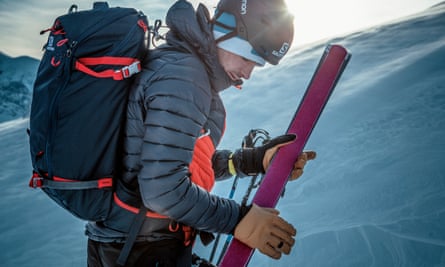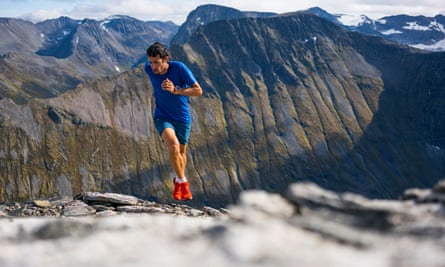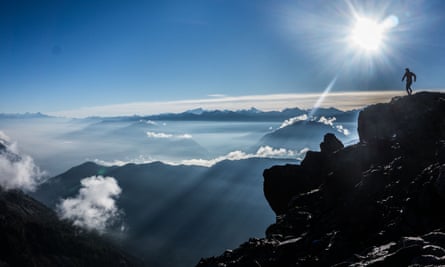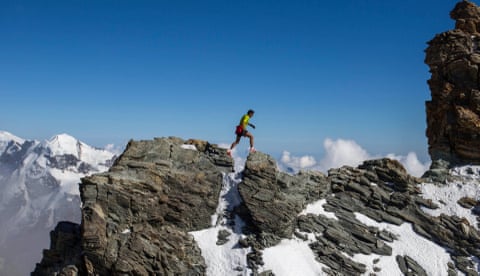More days than not, Kílian Jornet runs up a mountain. A short run will take him between one and four hours. A long run will take him five or more. Usually he’ll take a backpack with him, but for the sake of efficiency there won’t be much in it. “I can run for 10 hours, comfortably, without food or water,” he tells me, on a Zoom call. He’s not boasting – it is what it is. If he gets thirsty, he’ll drink from a stream.
Jornet is to endurance sports what Usain Bolt was to the 100m and Eliud Kipchoge is to the road marathon – an outlier and a record breaker. Most of his achievements seem basically inhuman. He has won every significant race on the mountain-running circuit, some of which are 100 miles long. He has broken nearly every mountaineering record in the world. He is the fastest man to have run up and down various big peaks, including Mont Blanc (normal time: two days; Jornet time: four hours, 57 minutes). In 2018, he scrambled to the top of Everest without supplementary oxygen but with a nasty bout of diarrhoea. (“I used a rock to wipe my ass,” he recalls in Above the Clouds, his latest book.) The frequent emergency stops frustrated him, and when he returned to camp he felt sure he could run it quicker. Three days later he tried again. What took him 26 hours first time around took him 17 hours on the second attempt.
Jornet has been a niche megastar for years – an unparalleled champion of mountain men. But now that society has woken up to the fact that exercise in the wild is both good for you and super cool, he has slipped into the mainstream consciousness. He’s landed tasty magazine covers (National Geographic, for the Everest ascents). He’s earned high-profile sponsor deals (Volvic, though he’ll often sip straight from the source). He has 1m followers on Instagram, where he shares footage that will make your knees wobble. Beneath a recent video of Jornet clambering across a mile-high ridge, one commenter wrote: “Fuck. Me.” Which pretty well sums up the normal reaction to most of what he does.
Even though it has helped his career, Jornet seems uneasy about his fame. In Above the Clouds he writes, “I didn’t choose to be admired.” As a kind of protest, he adds inverted commas whenever he uses the term “content creation”.“How an athlete makes a living, it has changed a lot,” he says. “Before, it was easy. You trained well, you performed well, you got a sponsor. It was based on performance. Now, performance is still a thing, but you also need to be…” – he mocks a shudder – “an influencer.” He pauses. “I prefer to consider myself an athlete rather than an influencer. There has to be some meaning.”
Jornet is 32. We’re speaking on a Monday morning at the end of August. Because of the way he has angled his computer, all I can see of him is his upper body. His hair is short, his arms are slim. He is wearing a black T-shirt that I imagine is designed to wick away sweat. “It’s been an interesting period,” he says, referring, understatedly, to the pandemic. All of his races have been cancelled; he’s had nothing to train for. He lives with his wife, Emelie Forsberg, who is also an elite endurance athlete, and their one-year-old daughter, who is currently the only member of this little tribe who does not run up and down mountains for a living. Their home is on the edge of a large fjord on the west coast of Norway. Their nearest neighbours live half a kilometre away. When I ask Jornet to describe the scene, he points his computer toward the view from his window and half-chuckles as though even he can’t believe his own luck. There is the water, grey-brown and rippling, and far off in the distance there are mountains, a lighter grey-brown, and that’s about it. It is a picture of escape.


For a long time, Jornet lived in Chamonix, in the French Alps, which is known as the world capital of mountaineering. Because everyone there is very into mountain endurance sports, and Jornet is the reigning king of mountain endurance sports, he was recognised a lot, which troubled him. So he and Forsberg moved to Norway, where there is so much space and so few people that he can disappear into the wild for hours without seeing anyone. This suits him just fine. Jornet describes himself as “very introverted”. Like many of us, he finds small talk tough. “For me, the small talk, it’s never easy,” he says. “We’re socially expected to make it. OK, but, like, why can’t I just be with a person for hours without talking?” He argues we’ve forgotten how to be quiet. “I feel that we connect silence with something bad, especially when we are with others. But we shouldn’t – sometimes silence can mean everything is fine!”
In his book, Jornet writes: “In the mountains, I never waver, but in the jagged terrain of relationships I’m paralysed.” He also writes: “For me, three is a crowd,” and variants of: “I have always found serenity in solitude.” He’s by no means a recluse – “you find a balance,” he says – but he often seems at odds with the modern world. He describes films as “productivity traps”. He’s concerned by overstimulation. “When I go to a city, or when I go to the sea, I feel I don’t belong there. I think, OK, that’s nice. That’s interesting. But I don’t feel comfortable. When I’m in the mountains, I feel like I belong.” In Above the Clouds, he writes: “Whenever I think about the speed of the modern world, the excess of information, stimulation, and stupid distractions, and how all this affects the body, I take off in my truck and hide away somewhere remote, where no one can find me if I don’t want to be found.”
Still, Jornet has a duty to emerge from the wild every now and then. He’ll need to have his picture taken, or meet with sponsors, or make some kind of material decision. (Part of his work involves consulting on the design of mountaineering gear.) “I visit cities not often,” he says. “A few times a year. And I enjoy it. But I know that if I stay more than two, three hours, a day… I wouldn’t say it’s depressing, but it feels like something is missing.”
I ask him if he considers what he does a job.
“Going to the mountains is my passion,” he says. “But I’m a professional athlete. There are interviews. I have contracts with sponsors. I have a social media thing.”
I ask, “Are you at work now?”
He replies with an apologetic giggle.
“Yeah. I’m working now.”

Jornet grew up in a mountain refuge in the Spanish Pyrenees. His father was a mountain guide, and the lodgings came with the job. (His mother was a teacher.) The family was big on nature, and Jornet’s parents taught him and his younger sister to commune with it. He likes to tell stories that emphasise their commitment to environmental education. Like this one:
“I remember when we were little kids still clinging to our mother’s legs, sometimes, after dinner, after we’d have put on our pyjamas and brushed our teeth, our mother would take us by the hand and lead us outside. We would go into the dark forest with no light to guide us. We would stray away from the paths and walk on the moss and fallen branches until we could no longer see the light from the house, and then she would let go of our hands, tell us to listen to the sounds of the forest, and find our way back to the refuge alone.”
Jornet’s parents’ passion became his passion, too. On the walls of his childhood bedroom were posters not of sports heroes or pop stars but famous mountains. For weekends and holidays, the whole family would leave their own mountain and travel to a different one, where they would explore the slightly different terrain. He became attuned to rocky landscapes. Stone. Moss. Scree. They became normal to him. By the age of four, he could hike 14km nonstop.
“My family,” he says, “they loved the mountains.”
When Jornet was in secondary school, he realised that he could not just withstand but actually enjoyed the suffering that came with running up a mountain, and he became fascinated by testing his own limits. “Normal kids of this age, they want to party,” he says. “And I was like, ‘OK, I don’t like partying. I don’t want to hang out after school. I just want to get on my bike and ride for seven hours.” Jornet has a remarkable ability to tolerate pain. (“Kilian is not normal,” Jornet’s mother once told the New York Times.) He acknowledges that there is extreme masochism in what he does – he refers to the suffering as “a perverse pleasure” – but it has never put him off. “It’s fun to know how far you can push your body,” he tells me.
I think, “Did he say fun?”
“It’s not the pain itself,” he says. “It’s that with the pain you know you are raising yourself to another level, another capacity. When you are putting yourself in these situations, when you’re suffering…”
“It’s what the pain represents,” I say.
He says, “It’s fun to explore how far you can go!”


When Jornet was at university, he started to question how far he could run without eating or drinking. What can a body withstand without fuel? Can it run on fumes? At one point he went five days straight without consuming anything: running, sleeping, running, sleeping. At a party a couple of days later, he fainted drinking a glass of orange juice. “My body was still recovering,” he says. He never went to another party again.
At times, Jornet’s life can seem relentlessly monastic. He doesn’t drink. He doesn’t smoke. As a kid, he made few friends, by choice. He thought social events were a waste of time. “I learned the contrast between what was considered normal and what was seen as abnormal,” he writes in Above the Clouds, of his school experience. “I belonged to the second group.” When he first joined the mountain running tour, as a broke teenager, he’d default on his bills for a month or two to save enough to reach his next race. (He has “more money than I need” now, he says.) He always thought he would grow up to “live in a remote, isolated house in the mountains, where it would take at least an hour to get to any inhabited place”, which is just about what has happened.
I ask him what he’s had to sacrifice to lead this life.
“I wouldn’t say sacrifice,” he says. “Of course, if you choose to open one door, another will close. But these are the choices that I’ve made. It’s not that I’ve sacrificed anything. This is the way it needed to be, but it’s the way I wanted it to be, too.”

Recently, Jornet has begun to consider what he might do next. He has become less excited about competition. He has achieved many of the things he always wanted to achieve. What more is there? The lockdown has spurred him into analysing his lifestyle – how he reconciles being an athlete with his deep connection to nature. “The sports model needs to change,” he says. “It cannot be just taking one group of people and moving them around the world to compete. That works for the audience, and for visibility, but it’s very bad for the environment. So maybe we need to do less. Not 10 races a year, only one, but make that one very special.” This paring back should apply to all parts of life, he argues – “not just sports, everything!” He vaguely points to his computer. “Like, now we’re doing a video call. That should become the norm. It was very common a few years ago to travel to do an interview, to send a photographer from the other side of the world to take a picture. Is that what we want? We need to rethink. What’s my role as an athlete? What can I do? How can I preserve the mountains? And, as a collective, how can we change the future of sport so it’s more responsible?”
Sometimes, it can seem as though Jornet is conflicted by his profession, as if it is ultimately pointless. “It’s a very stupid thing,” he says, “when you are running just for running. If you are running because a lion is chasing you, then it’s not pointless. Then it’s for survival. But just to run? Sports in general, it’s playing a game. It’s not like a teacher educating new generations, or a doctor who is saving lives. It’s putting one foot after the other. It’s fun. But it’s not important.” And yet, in Above the Clouds he writes, “I accept that, inwardly, running is everything.”
He’s unsure what will come next. He will continue to race, but he will spend more time running locally. He will get up in the morning and disappear into the mountains that surround his home for an hour or two or five. Perhaps, simply, he will run for enjoyment. And perhaps he has been doing that all along. “I want to be an 80-year-old boy,” he writes in his book, of his future. “I want to experience every phase of my love for the mountains with total madness, with my eyes shining brightly, my heart beating wildly and out of control, my legs shaking from having just climbed up a mountain. Until, when I’m truly old, my body stops working for good.”
Above the Clouds by Kílian Jornet (HarperCollins, £14.99). Buy it for £13.04 from guardianbookshop.com
